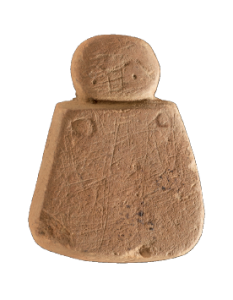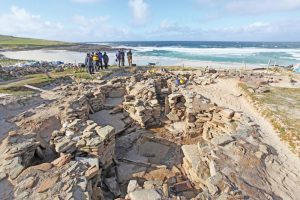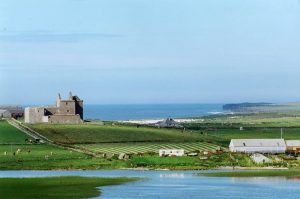

At the time of the earliest known settlements, c. 3500 BC, in Westray and neighbouring Papa Westray, it is believed that the two islands were joined. A Neolithic and Bronze Age site at the Links of Noltland is in the care of Historic Scotland. The site is severely threatened by the rapid erosion of the overlying sand dunes. Ongoing excavations have revealed over 30 buildings of Neolithic and Bronze Age date, the earliest of which overlaps in use with the Knap of Howar on the neighbouring island of Papay, the oldest standing structure in NW Europe. The Westray Wife, 4 cm carved Neolithic figurine was discovered on the Noltland dig in 2009 – this is the oldest carving of a human found in the British Isles. Since then, four further figurines have been found, together with a wealth of other artefacts (carved stone ball, decorated grooved ware pottery, numerous carved bone objects and beads etc.). More recently (2015) a substantial subterranean building of Bronze Age date was uncovered – this was very well preserved and is interpreted as a sauna. The excavations won ‘Best Rescue Dig’ of the year in the prestigious 2014 Current Archaeology awards. Several of the figurines and other artefacts from the site can be seen at Westray Heritage Centre and the excavation is open seasonally to visitors (free of charge). The Heritage Centre also exhibits the ‘Westray Stone’- a neolithic carved stone from a chambered tomb which closely resembles the art style of the Boyne Valley in Ireland.
The “Westray Wife” Neolithic carved figurineWestray constituted a major family estate during the saga period. Large scale excavations of Viking- Norse period sites have been undertaken at Tuquoy, Quoygrew and at Langskaill in recent years.

And it was at Noltland on Westray too, that one of the most impressive castles in Orkney, and indeed the Northern Isles, was built, Noltland Castle. The castle was commissioned in the 1560s by Gilbert Balfour, who probably played the leading role in the murder of Lord Darnley, consort of Mary, Queen of Scots. Balfour married Margaret Bothwell, the sister of Adam Bothwell, Bishop of Orkney who endowed him with Westray, when it was episcopal property. The Castle is situated above the Bay of Pierowall, was built in the 1560s. It is notable for an unusually large spiral staircase, “second only to Fyvie Castle, while its triple tiers of gunloopsare without parallel in Scotland, if not Europe”. However, Balfour was executed by the Swedes before he could use it.
Other attractions include the Romanesque Cross Kirk and the Castle O’Burrian sea stack once used as a hermitage.
